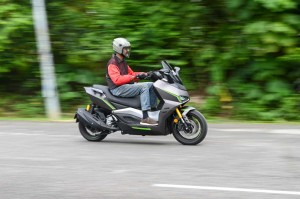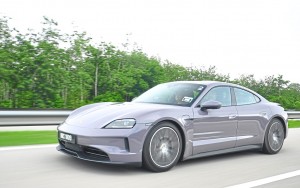PETALING JAYA: Glow-in-the-dark road markings in Semenyih, Selangor, have impressed many people across the country.
The pilot project, which was launched at a 245m stretch between Jalan Sungai Lalang and Jalan Sungai Tekali, has garnered so much attention that at least a few other states – namely Kedah and Melaka – have started their own trials.
Johor is also expected to start testing it out soon.
However, there are mixed reactions on the cost-effectiveness of the project by Hulu Langat Public Works Depart-ment (JKR) versus the value it brings.
JKR Hulu Langat district director Mohd Zamri Mohamud said the glow-in-the-dark road markings were to enable cyclists to ride at night even along dark stretches.
“The photoluminescent road markings cost much more than conventional paint.
“So the project must have additional value if the state approves the funds for it,” he said.
According to a news report, Works Minister Datuk Seri Alexander Nanta Linggi said the photoluminescent paint cost RM749 per sq metre, compared to RM40 per sq metre for conventional road marking paint.
This makes photoluminescent paint about 19 times more expensive.
However, Nanta commented that the glowing road markings received positive feedback from the public.
Mohd Zamri said Hulu Langat was popular among cyclists.
“During the day, especially on weekends, many cyclists can be spotted here but not at night.

“Now that we have this glow-in-the-dark feature, we hope that cyclists will ride here at night too,” he said.
Glow-in-the-dark markings for cyclists are not new in other parts of the world, especially in bicycle-friendly countries such as the Netherlands and Poland.
Luminous stretches were laid out on bicycle lanes in those countries about a decade ago.
However, Mohd Zamri acknowledged that streetlights were still the best option for illumination, being more cost-effective and brighter.
He said the glow-in-the-dark markings would make it safer for travellers on streets without electricity supply connection.
“But not all roads are suitable for this feature.
“The area must be really dark so the markings can stand out and glow brightly.
“The glowing effect is expected to last some 10 hours every night, with its brightness fading gradually throughout the night.
“We are also testing other glow-in-the dark paint made from different materials, including glass beads that will not only glow but also reflect light,” he added.
Mohd Zamri said the technology was very new in Asia and not much testing had been conducted in tropical countries.
“We do not know how the innovative road markings will fare in the long term in our weather conditions,” he said.
Avid cyclist Nur Sarida Said, 39, who hails from Semenyih and is familiar with the cycling routes in Hulu Langat, said any extra illumination would help cyclists navigate better.
“I have cycled in Hulu Langat many times during the day and also a few times at night when the roads are pitch dark.
“We often cycle as a group and at night, we will fix lights on our bicycles, one on the front and another on the back.
“I have not had the opportunity to see the glow-in-the-dark markings.
“I believe the markings will help us navigate better at night because the roads here are narrow with sharp corners.
Orbit Cycle Trading owner Syamsul Anuar, who is a keen cyclist, said the authorities should consider the cost-effectiveness of projects requiring big budgets and get the views of cyclists first.
He said all cyclists would have lights on their bicycles before starting their night rides, even when riding on brightly lit roads like the ones in Putrajaya.
“I am not sure how useful the glow-in-the-dark markings will be.”
Malaysian Institute of Road Safety Research central director Dr Muhammad Marizwan Abdul Manan said the move to increase safety for travellers was welcome but he had doubts about the effectiveness of the glow-in-the-dark markings.
He said the glow might serve as a nice attraction but would not have much effect on road safety, as all vehicles were expected to have lights.
“When it comes to road safety, other aspects like having well- maintained roads and clear markings, including chevron and reflective road markings, will be more cost-effective.
“Another concern is that the glow-in-the-dark effect may divert the attention of road users.
“Some motorists, out of curiosity, might slow down to look at the luminous lines, which is dangerous,” he said.
The high cost of glow-in-the-dark road markings and their maintenance was also a concern, Marizwan said, especially since public funds were being used.
“Perhaps photoluminescent markings are better suited for private roads, where only the users, and not all taxpayers, will pay for the added feature that they benefit from,” he said.












